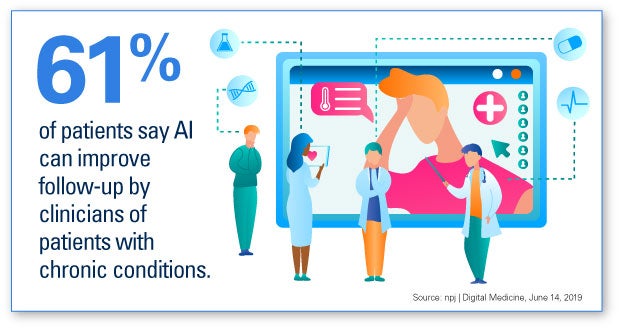

Assessing AI’s Potential for Care Delivery

Artificial intelligence has created new opportunities to transform how care is delivered, while offering the potential to improve outcomes and lower costs at each stage of the care cycle. AI does this by using data for:
- Prevention: Identify patients at risk for disease.
- Detection: Identify changes in patients’ medical conditions.
- Diagnosis: Enable more accurate and faster evaluations.
- Treatment: Customize medical care for individual patients.
A new AHA Center for Health Innovation Market Insights report, “AI and Care Delivery,” examines what hospital and health system leaders need to build a powerful AI infrastructure of people, policies, resources and technology. The report also explores ways to reimagine care delivery with AI technologies, including ways to use AI to prevent disease, improve health and detect changes in patients’ health status.
A panel of experts, including members of the AHA Committee on Clinical Leadership, identified the four building blocks below as critical for any provider hoping to establish an effective clinical AI program.
People: Hospitals and health systems will need to set up organizational charts and assign responsibilities to a group of leaders who not only will oversee the priority and execution of AI projects, but also will be accountable for their outcomes. The report lists many of these roles, as well as where to turn for expertise to support an AI program.
Policies: Because data governance is a critical component of any effective clinical AI program, hospitals and health systems will need strong policies in this area to protect the privacy and security of patient data flowing into and out of an AI algorithm.
Resources: Hospitals and health systems that deploy AI to improve care across the continuum will need to allocate financial resources and time to ensure that the AI-enabled solution produces the outputs expected by senior leaders.
Technology: Lastly, providers will need to invest in technologies that not only integrate actionable AI insights into the workflow on the front end, but also technologies that feed accurate data into AI algorithms to generate insights.

The AHA Center for Health Innovation website also offers leaders a suite of other AI resources, including:
“AI and the Health Care Workforce”: Providing a useful framework and tools for hospital and health system leaders to think critically about their AI strategy, this Market Insights report examines how AI may impact workforce strategy and how to successfully integrate AI technologies into your workforce and workflows.
“AI Workforce Discussion Guide”: This member-only guide identifies considerations and steps that will help leadership teams understand the implications of AI on workforce strategy and ensure successful and effective AI integration into the health care workforce.
“Surveying the AI Health Care Landscape”: Offering an overview of the health care AI field, this Market Insights report discusses common use cases for AI technology and provides a sampling of vendors that sell, test and develop AI solutions.
“AI Vendor Selection Tips”: Available to AHA members, this resource provides questions to ask potential vendors and helps you set up a partnership for success.
“AI Scenario Planning”: This document will guide you and your leadership team through what-if scenarios to help you visualize, ask questions and plan for an AI-enabled future.



